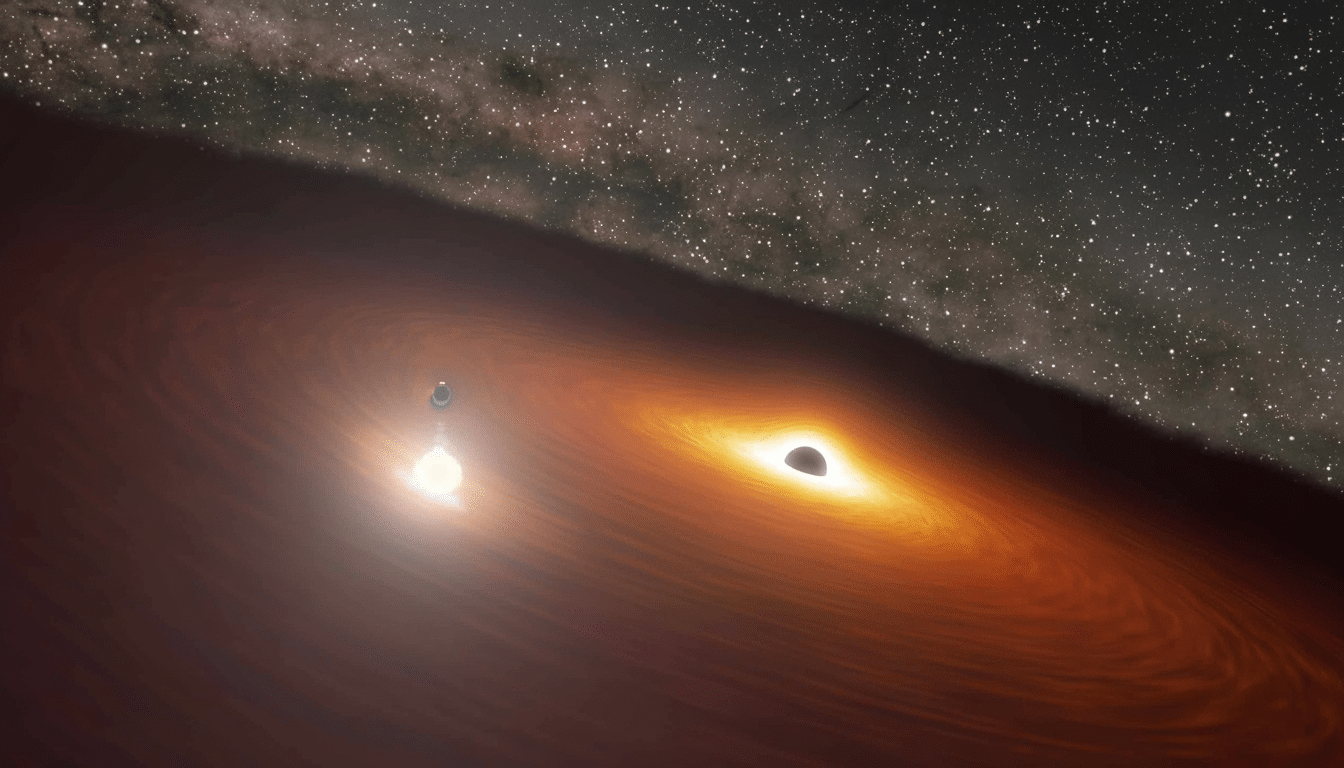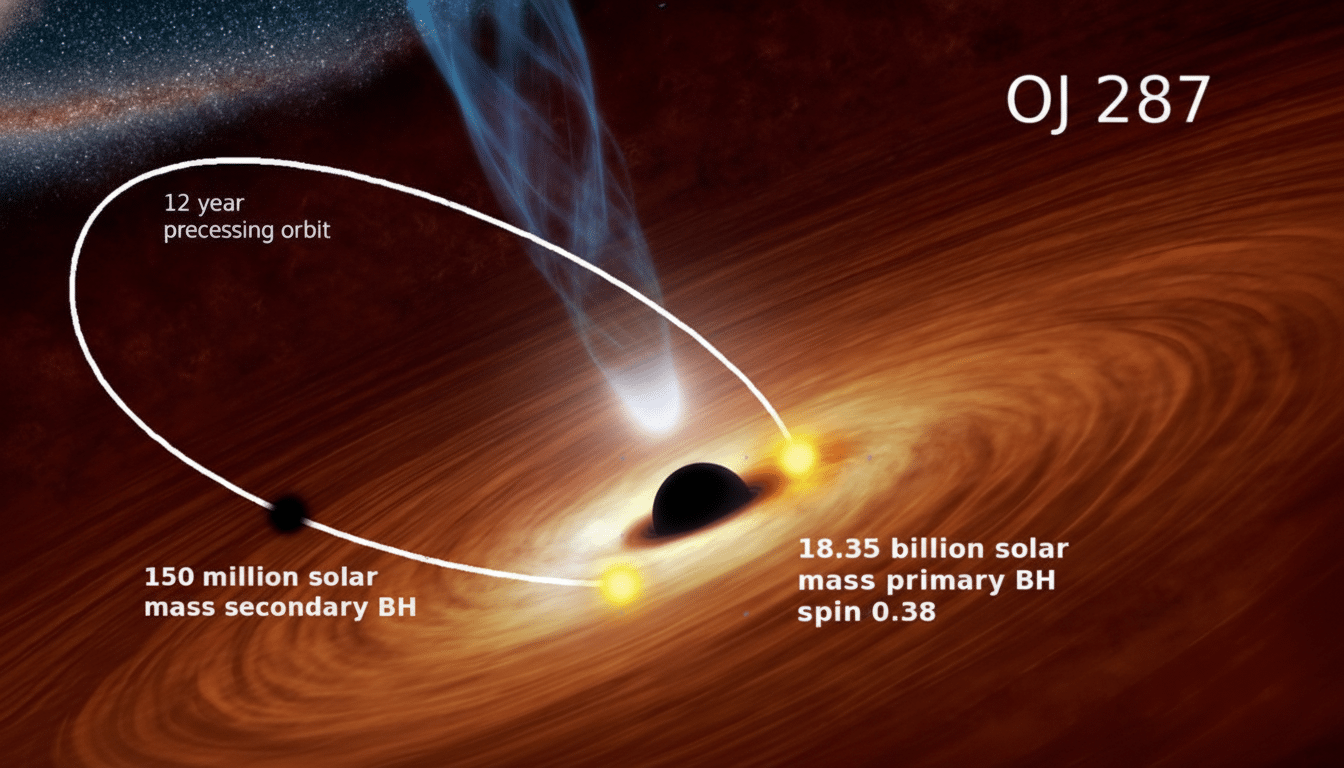For the first time, astronomers have determined two enormous black holes are locked in orbit around each other after spotting them with a powerful radio ‘eye.’
The finding offers direct visual proof that paired giants do exist — and both can be active at the same time — paving the way for an important advance in the quest to understand black hole astrophysics.

OJ 287, an intensely bright quasar some 3.5 billion light-years away, has puzzled scientists for decades with a strange clockwork pattern in its light.
That 12-year beat was a telltale sign of two black holes engaged in a gravitational do-si-do. Now, employing space–Earth radio interferometry, scientists have observed two compact jet-producing cores that are indicative of a binary supermassive system.
The picture also highlights a bright, twisting jet linked to the smaller companion, which seems to pivot as the object orbits. Combined, these features transform a case based on generations of monitoring and modeling into a direct, high-resolution look at a cosmic couple.
How Scientists Finally Caught The Pair In OJ 287
The breakthrough was made possible by space-boosted very long baseline interferometry. By connecting the Russian RadioAstron spacecraft to radio dishes on Earth, the team was able to effectively extend their baseline of observation beyond Earth’s diameter, increasing their resolving power down to scales of microarcseconds. That resolution leap, impossible with ground-only arrays, enabled the two radio-bright cores to be cleanly split in OJ 287.
The research, led by Mauri J. Valtonen of the University of Turku and published in The Astrophysical Journal, is based on years of Earth-based campaigns that suggested a binary but could not identify two separate cores. Co-authors add that in this context, space-assisted VLBI provides the key angular resolution to separate structures deep within a quasar’s central engine and has been shown to be capable of revealing that each black hole probably produces its own relativistic jet.
RadioAstron, also called Spektr-R, circulated in a wide orbit around the Earth and away from it by hundreds of thousands of kilometers. By combining the signals received by the spacecraft’s antenna with those coming from ground stations around the world, the team effectively created a telescope bigger than Earth — an approach that transforms faint, distant structures into resolvable images.
What Makes OJ 287 A Unique Cosmic Laboratory
OJ 287 has certainly been a cosmic enigma ever since it suddenly appeared on early photographic plates. In the 1980s, Finnish astronomer Aimo Sillanpää suggested that its eruptions simply indicated that two supermassive black holes were orbiting one another. Modeling later indicated that there was a huge primary, in the neighborhood of 18 billion solar masses, and a much smaller secondary, roughly 150 million solar masses.

According to the best models, the lighter black hole makes a dive through the larger one’s accretion disk once every 32 hours, setting off explosive fireworks at predictable times. That geometry not only describes the 12-year rhythm, but also predicts that the pair’s jets might precess and twist as the orbit changes — behavior the new radio image starts to record.
With the excellent timing of OJ 287, it has been established as a precision testbed for accretion physics, black hole spin alignment, and general relativity. The new image provides direct input to these models, anchoring decades of light-curve analysis with spatially resolved structure.
Why The Picture Matters For Gravity And Cosmic Mergers
Binary supermassive black holes are the missing pieces between galaxy mergers and the monster black holes located in nearby centers of galaxies. Nailing down their orbital motions and the behavior of their jets is key to figuring out when and how they merge, which rattles spacetime and drowns the cosmos in low-frequency gravitational waves.
Recent discoveries by pulsar timing consortia like NANOGrav, the European Pulsar Timing Array, and the Parkes Pulsar Timing Array suggest such a background hum of nanohertz gravitational waves generated predominantly by populations of such systems. And a solved system like OJ 287 allows scientists to calibrate that background against dynamics in the real world, providing better estimates of the rates at which black holes merge and on the cosmic timeline for how rapidly black holes can grow.
Building on Earlier Black Hole Photos and Insights
This milestone is different from the historic images released by the Event Horizon Telescope (EHT) of M87* and Sagittarius A*, which showed horizon-scale silhouettes of individual black holes. In OJ 287, the astronomers are not looking at silhouettes, but two active nuclei and their jets in one system. And the difference between them is crucial: One method delves into the edge of a black hole in its immediate vicinity; the other surveys the architecture of the binary engine.
Both rely on international partnerships and precisely timed radio arrays. By extending baselines to space, the OJ 287 team mapped structures that ground networks alone could not, providing a new window on observing black hole pairs.
What Comes Next For Tracking This Binary Black Hole
With two cores out of the way, motion is the next priority. Further observations will also monitor the motion of the smaller black hole’s jet direction and separation as it takes its waltz around the larger. Coordinated campaigns in the radio, optical, and X-ray bands will try to catch future disk impacts while detailing how the jets respond.
Future facilities such as the Square Kilometre Array and planned space-VLBI missions would enable supermassive binaries to be counted in a more robust sense, rather than of order just a few systems. Each new system will place tighter limits on strong-field gravity and contribute to an understanding of how galaxies — and the black holes that sit at their centers — grow in concert over cosmic time.

